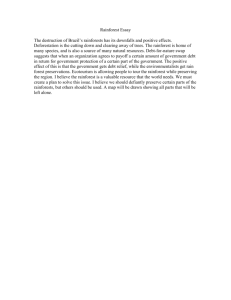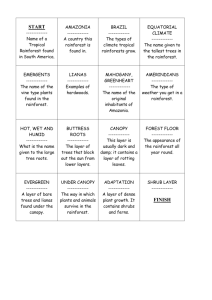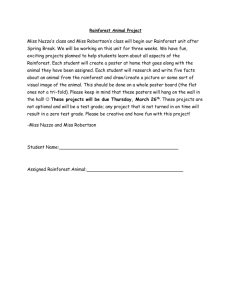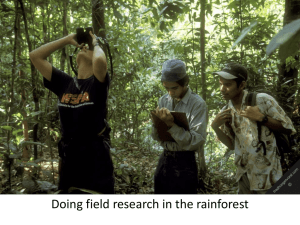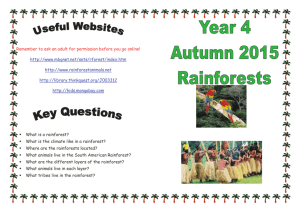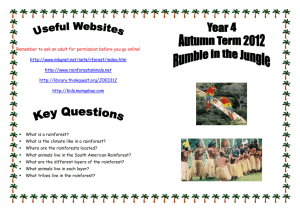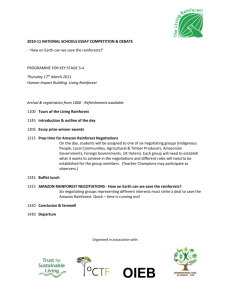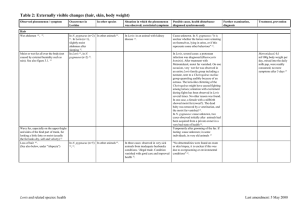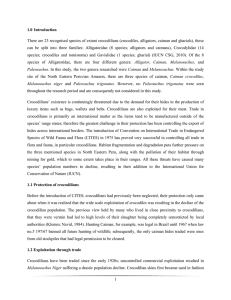The Rainforest
advertisement
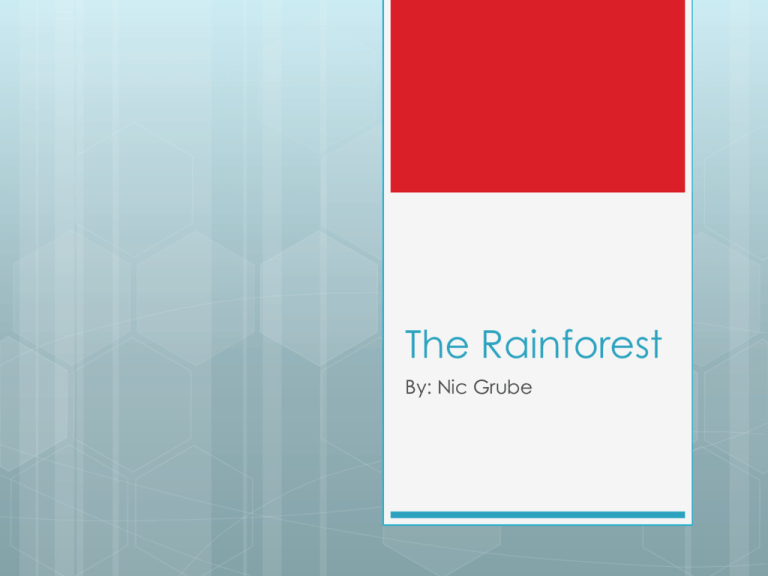
The Rainforest By: Nic Grube Animals Of The Rainforest 1. 2. 3. 4. 5. 6. 7. 8. 9. 10. The Golden Lion Tamarin The Capybara The Black Caiman The Bengal Tiger The Silvery Gibbon The Slender Loris The Kinkajou The Binturong The Basilisk Lizard The Pygmy Marmoset The Golden Lion Tamarin http://www.bagheera.com/inthewild/van_anim_tamarin.htm The Golden Lion Tamarin Only about 400 of them are left in the Amazon. Huge rivers , barren lands, and croplands make it so these monkeys are hard to get to and so its hard for the monkey to get out as well. Acrobatic, quick-moving monkeys Analytical masters of their arboreal world. Endangered and lives in the Tropical Rainforest The Capybara http://nationalzoo.si.edu/Animals/Amazonia/Facts/capybarafacts.cfm http://gainesvillewildlifecontrol.com/gainesville-alachua-high-springsbranford-can-you-say-capybara/ The Capybara Weigh more than 100 lbs. An herbivore that eats grass and aquatic plants Highly social and males control groups Can remain underwater for up to 5 minutes Reddish Brown fur on top and Yellow Brown fur underneath The Black Caiman http://www.theanimalfiles.com/reptiles/crocodiles_alligators/black_caiman.html http://www.flickriver.com/photos/artour_a/4594734018/ The Black Caiman Feed on fish, water birds, Capybara, and sometimes domestic animals Lay 30-65 eggs Usually lay eggs in mound of vegetation and soil The Female watches the eggs Can grow to be 13 – 20ft long Live in lakes and slow moving rivers Jaguars as well as humans are predators of the Black Caiman Life Expectancy is 50 – 80 years The Bengal Tiger http://animals.nationalgeographic.com/animals/mammals/bengal-tiger/ The Bengal Tiger Have great power and strength and are the largest of the cat family Most common tiger and populates about half of the tiger population Lives in India and is sometimes known as the Indian Tiger Are hunted for body parts and for the use in Chinese medicine This species is endangered and its roar can be heard from 2 miles away Life Span is 8 – 10 years in the wild Weighs anywhere from 240 – 500lbs. The Silvery Gibbon http://www.blueplanetbiomes.org/silvery_gibbon.htm www.daughterearth.com The Silvery Gibbon Make a song that can be heard over a mile and last 7 minutes (Only females sing) Live in treetops of the Javas Rainforest Songs can be different and can show territory (Territory is about 42 acres) If intruders are seen it is the males job to crash through the forest after them Known as lesser apes and have no tail Usually weigh only 13lbs. And have long arms Eats fruit, flowers, and young leaves Gestation Period- 7-8 months and must wait 23 years between births The Slender Loris http://animal.discovery.com/guides/endangered/mammals/slender-loris.html http://www.edgeofexistence.org/mammals/species_info.php?id=22 The Slender Loris Weigh 103 – 172 grams Has long and slender arms and legs Curl up in balls during days and are active and social at night The Highland Slender Loris lives at the canopy level at 1,800–2,300 meters altitude The Red Slender Loris lives at the primary and secondary lowlands level up to 900 meters in altitude The Kinkajou http://ngm.nationalgeographic.com/ngm/0310/feature2/zoom2.html The Kinkajou http://www.blueplanetbiomes.org/kinkajou.htm Sleeps in upper canopy and in holes in trees Nocturnal Weighs anywhere from 3 to 10lbs. Golden-Brown fur Round head, big eyes, small ears, and snout like a bear’s Soles of feet provide grip Moves by climbing and jumping Solitary and can live over 23 years Rarely seen ,but not endangered Carnivore Prehensile tip to tail which helps climbing The Binturong http://a-z-animals.com/animals/binturong/pictures/1187/ The Binturong Carnivore Long snout and many teeth AKA Bearcat Females 20% larger and heavier than males Dark-Brown to Black shaggy, coarse fur and tipped with gray Prehensile tip to tail that helps climb and acts like an extra leg Nocturnal To big to leap from tree to tree so must climb down tree then walk to another The Basilisk Lizard http://animals.nationalgeographic.com/animals/reptiles/green-basilisk-lizard/ The Basilisk Lizard AKA plumed or double-crested basilisk Able to run on water Spend time in trees, but are always close to water If threatened it can drop from tree and land in water and run 5 feet per second across the surface Can go across surfaces of water for 15 feet or more Even when in water they swim very well The Pigmy Marmoset http://pygmymarmoset.net/pygmy-marmoset-pictures.html The Pigmy Marmoset Usually have twins, but can have triplets and quadruplets Newborns must be fed every 2 hours Claws that help cling to trees Omnivore Can live to be 15 years old Small size helps hide from predators Still chases intruders on their territory even though they’re so small Plants Of The Rainforest 1. 2. 3. 4. 5. 6. 7. 8. 9. 10. The Rafflesia Plant Bromeliads The Strangler Fig Lianas Bengal Bamboo The Giant Corpse Flower The Bladderwort The Victoria Amazonica The Walking Palm Tree The Belladonna The Rafflesia Plant http://www.arkive.org/rafflesia/rafflesia-spp/image-G19163.html The Rafflesia Plant Largest Can Has single flowers in the world reach over 90cm across leathery petals Actually Vines) Found a virus, but grows on host(Tetrastigma in primary and secondary rainforests Bromeliads http://www.srl.caltech.edu/personnel/krubal/rainforest/Edit560s6/www/plants/bromeliads.html Bromeliads Thick, waxy leafs Related to pineapple family Bowl shape in center of leafs Bowl shape makes great habitat for small animals When animals die it gives the plant nutrients The Strangler Fig http://www.mongabay.com/04strangler_fig.htm The Strangler Fig Hollow on inside A root that starts in ground then slowly grows up host tree When host tree dies it leaves the inside hollow Produces Hard large amounts of fig fruit for loggers to cut through so usually stay there when a forest is cleared Lianas http://www.tutorvista.com/biology/plants-in-a-tropical-rainforest http://www.srl.caltech.edu/personnel/krubal/rainforest/Edit560s6/www/plants/lianas.html Lianas Thick, Can woody stems grow up to 3000 feet Attach to trees and grow on trees towards sunlight Bengal Bamboo http://www.blueplanetbiomes.org/rnfrst_plant_page.htm ` ` Bengal Bamboo The Giant Corpse Flower The Giant Corpse Flower The Bladderwort The Bladderwort The Victoria Amazonica The Victoria Amazonica The Walking Palm Tree The Walking Palm Tree The Belladonna The Belladonna Rainforests Around The World 1.) The Amazon Rainforest Location- South America Fact- Home to 1/5 species of all plants and 1/10 of all mammal species. Also home to second longest river. 2.) The Congo Rainforest Location- Africa Fact- Covers more than1,000,000 square miles 3.) Other Rainforests Location- Madagascar or Central Africa Location- South East Asia and Southern Asia- Bangladesh, Borneo, Java, Burma, and even Malaysia Location- Australia- New Guinea and New Zealand http://www.srl.caltech.edu/personnel/krubal/rainforest/Edit560s6/www/where.html#AF
